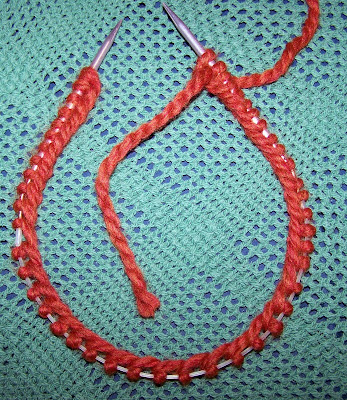
Inspiration:
Current Knitalongs:
2007-10-10 : 6:10 p.m.
How I join without twisting...
When I first learned to knit in the round, I was totally in love! I hate seaming and knitting in the round makes it so you get to skip a whole bunch of that. Plus, you can knit socks which floats some people's boats. Later on, I started seeing patterns and episodes of Knitty Gritty with the instructions "Join and knit in the round, BEING CAREFUL NOT TO TWIST" and I thought "Omg, how does that happen?" because it hadn't ever happened to me in my blissful ignorance. Of course, after discovering this fact, I promptly paid more attention to what I was doing.
My first suggestion if you're having trouble with this is to not start out with a completed object in mind. Start out with a pair of shorter circulars or set of dpns and cast on several dozen stitches (or enough to just fit your circular), firmly but not immovable, with a leftover yarn. I think the best cast on to start out with is a long tailed cast on because it is fast and gives you a nice thick 'braid' to judge stitch orientation with. Now, if you've done this, you'll hopefully end up with something that looks like this:
If you don't have something that looks like this, lay it down on a flat surface and rearrange. This works with DPNs as well, just lay them in a triangular or diamond pattern. It doesn't matter how the needles lay as long as the stitches look that way, especially the first stitch after the working yarn. If you started out your long-tailed cast on with a slip knot rather than just laying the yarn over the needle, it may look a little different, but the thick part should still be on the inside.
This is easiest when your needle is almost too long for your stitches because of the way the braid pulls in. Take the time to figure out how this looks because as you add stitches, they'll move around more and you'll have to go down the braid the whole length of the needle and make sure it is pointed the right way before you start.
The next trick is to pull the tail of the last stitch you cast on through the front of the first stitch, preferably while you still have it laid out nicely on the table, like so:
If you keep the tail pulled tight as you pick it up, your non-twisting circle should be preserved and once that first stitch is knit, you can't put any twists in it.
Remember: You *can* knit for an inch *before* you join and then seaming the inch up later when you are just beginning to knit in the round.

